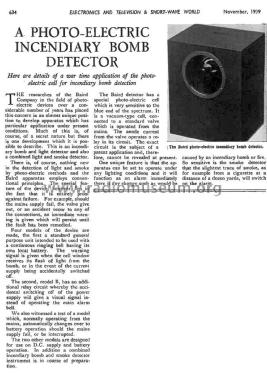Photo-Electric Incendiary Bomb Detector.
Baird (brand) - John Logie, Ltd.(Television); Scophony-Baird; London
- Country
- Great Britain (UK)
- Manufacturer / Brand
- Baird (brand) - John Logie, Ltd.(Television); Scophony-Baird; London
- Year
- 1939
- Category
- Miscellaneous (Other, Various) - see notes
- Radiomuseum.org ID
- 345973
- Main principle
- Special principle (see notes)
- Wave bands
- - without
- Power type and voltage
- Batteries / addl. power jack
- Loudspeaker
- -Loudspeaker incorporated, but system not known.
- from Radiomuseum.org
- Model: Photo-Electric Incendiary Bomb Detector. - Baird brand - John Logie, Ltd.
- Notes
-
Photo-Electric Incendiary Bomb Detector.
Here are details of a wartime application of the photoelectric cell for incendiary bomb detection.
The research of the Baird Company in the field of photoelectric devices over a considerable number of years has placed this concern in an almost unique position to develop apparatus which has a particular application under present conditions. Much of this is, of course, of a secret nature but there is one development which it is possible to describe. This is an incendiary bomb and light detector and also a combined light and smoke detector.
In the detection of light and smoke by photo-electric methods and the Baird apparatus employs conventional principles. The special feature of the device, however, lies in the fact that it is entirely proof against failure. For example, should the mains supply fail, the valve gives out, or an accident occurs to any of the connections, an immediate warning is given which will persist until the fault has been remedied.
Four models of the device are made, the first a standard general-purpose unit intended to be used with a continuous ringing bell having its own local battery. The warning signal is given when the cell window receives its flash of light from the bomb, or in the event of the current supply is accidentally switched off.
The second, model B, has an additional relay circuit whereby the accidental switching off of the power supply will give a visual signal instead of operating the main alarm bell.
We also witnessed a test of a model which, normally operating from the mains, automatically changes over to battery operation should the mains supply fail, or be interrupted.
The two other models are designed for use on a DC supply and battery operation. In addition, a combined incendiary bomb and smoke detector instrument is in course of preparation.
The Baird detector has a special photo-electric cell that is very sensitive to the blue end of the spectrum. It is a vacuum type of cell, connected to a standard valve which is operated from the mains. The anode current from the valve operates a relay in its circuit. The exact circuit is the subject of a patent application and, therefore, cannot be revealed at present.
One unique feature is that the apparatus can be set to operate under any lighting conditions and it will function as an alarm immediately if there is any change such as would be caused by an incendiary bomb or fire. So sensitive is the smoke detector that the slightest trace of smoke, for example from a cigarette at a distance of a dozen yards, will switch on the alarm.
- Mentioned in
- -- Original prospect or advert (Electronics And Television & Short-Wave World Nov 1939, Page 634.)
- Author
- Model page created by Gary Cowans. See "Data change" for further contributors.
- Other Models
-
Here you find 75 models, 48 with images and 38 with schematics for wireless sets etc. In French: TSF for Télégraphie sans fil.
All listed radios etc. from Baird (brand) - John Logie, Ltd.(Television); Scophony-Baird; London
